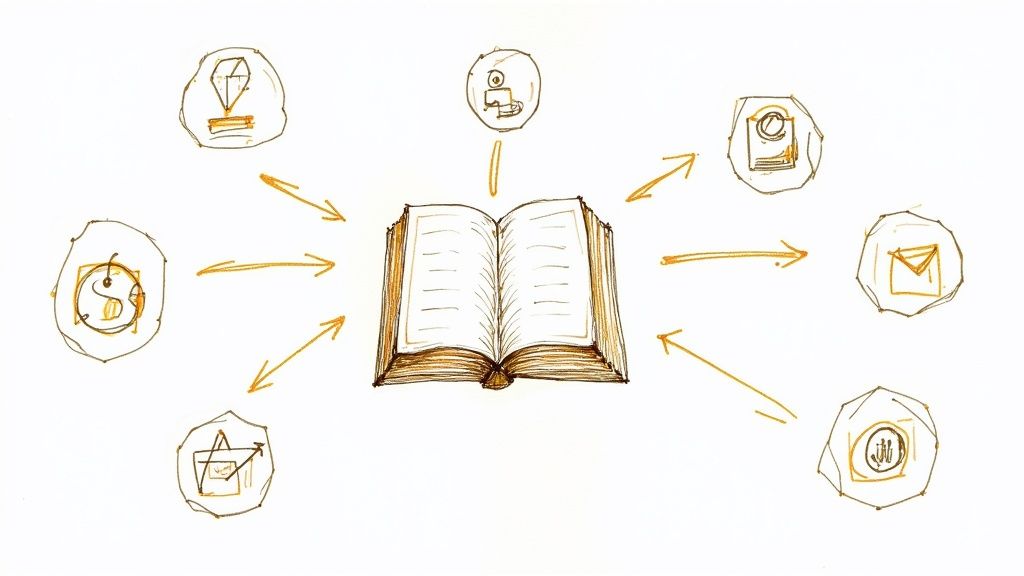How to Market a Self Published Book That Actually Sells

Why Most Self-Published Books Stay Invisible

Let's be honest, the self-publishing world is exciting and full of potential. But that huge surge in indie authors also means a ton of competition. It's ridiculously easy for a book to get buried, even a good one, especially if you're still clinging to the old "write a great book and it'll sell itself" myth. That advice just doesn’t cut it anymore.
Reader habits have totally changed. We're all drowning in content. Attention spans are shorter than ever. Readers are picky. They don't just magically find books; they're actively hunting for specific things they're interested in. So even an amazing book needs a solid marketing plan to get noticed. Think of it like a jam-packed bookstore – your book might be the best one on the shelves, but if it's hidden away, no one will ever see it.
Self-publishing has exploded. We're talking a 264% increase in self-published works over the last five years! In 2023 alone, the US saw 500,000 new self-published titles, compared to just 10,000 from traditional publishers. That difference is insane, and it really shows you the uphill battle indie authors face. Check out these stats on self-publishing growth for more context. This crowded market makes smart marketing absolutely essential.
Understanding the New Reader Landscape
So, what's the takeaway for you? You need to become your own marketing whiz. You need to figure out how to reach readers in this new world. It's not about pushy sales tactics; it's about making genuine connections, building an audience, and positioning your book strategically. It's about understanding things like algorithms, keywords, and how to create marketing copy that actually speaks to your ideal reader.
From Invisible to Indispensable: Real-World Examples
I've seen firsthand how the right marketing can completely change a book's fate. I talked to one author, let's call her Sarah, who self-published a fantasy novel that initially went nowhere. After working with ManuscriptReport.com to improve her keywords, run targeted ads, and build a better online presence, her sales jumped by over 400% in just three months. Another author, Mark, used ManuscriptReport.com to create a blog series based on his non-fiction book. This drove a ton of traffic to his website and boosted his Amazon ranking. These aren't just lucky breaks; they're examples of what's possible with a strategic approach to book marketing.
The next sections will give you the knowledge and tools you need to make your book discoverable, attract readers, and build a successful self-publishing career. You’ll learn to create a marketing plan that works for you, avoid common mistakes, and finally connect with the readers who are out there waiting to find your work. Remember, the goal isn't just to publish; it's to get your book into the hands of people who will love it.
Building Your Reader Magnet Before Launch Day

So, you’ve finished your book. Awesome! Now comes the part so many self-published authors overlook: pre-launch buzz. Think of it like a movie premiere. Hollywood doesn't just drop a film on the public without any fanfare. Trailers, posters, interviews – it's all about building anticipation. Your book launch should be no different. You need a reader magnet, something that draws people in and gets them excited to buy.
I've seen too many authors treat their websites like digital business cards – static pages with a bio and book cover. That’s not going to cut it. You need a website that engages, informs, and makes people want to learn more.
Creating a Website That Converts
A truly effective author website is a dynamic hub that keeps readers coming back. Think of it as your online home base, a place to connect with readers and build your audience. Here's what I recommend:
- Engaging Content: Share valuable content related to your book's genre or topic. Blog posts, articles, even short stories – give potential readers a taste of your writing and establish yourself as an authority in your niche.
- Email Capture: This is absolutely essential. Offer a freebie – a sample chapter, bonus content, a short story – in exchange for an email address. Your email list is your direct line to your readers. It’s how you’ll announce your launch to a group of people who are already interested in your work.
- Compelling Author Bio: Don’t just list your credentials. Share your story, your passions, what makes you you. Connect with readers on a personal level. People buy from people they trust.
This shifts your focus from selling to serving. It's about building a community around your work. This mindset is key.
Strategic Online Presence
Your online presence extends beyond your website. Think social media, author platforms, online communities. Recent trends indicate 75% or more of book buyers discover new books online. And guess what? Authors using targeted landing pages see conversion rates jump by 20-30%. Discover more insights about online book discovery. Choosing the right platforms and using them effectively is a game-changer.
Don't try to be everywhere at once. Focus on the platforms where your target audience hangs out. Romance author? Instagram and Goodreads might be your best bet. Business writer? LinkedIn and Twitter could be more effective. The point is to engage authentically, not just blast out promotional messages.
Landing Pages that Convert
Landing pages are a secret weapon in your marketing arsenal. Create dedicated pages on your website for specific campaigns, like your book pre-order. These pages should have one clear call to action: sign up for your email list, pre-order your book, etc. Keep it simple and focused.
Let’s talk about how these website elements impact your conversion rates. I’ve put together a handy table summarizing key components:
To help you prioritize, here's a breakdown of essential website elements and their impact on converting browsers into buyers:
Essential Author Platform Components Comparison: A breakdown of key website elements and their impact on reader conversion rates
| Platform Element | Conversion Impact | Implementation Difficulty | Time Investment |
|---|---|---|---|
| Engaging Blog Content | Medium | Low | Medium |
| Email Signup Form | High | Low | Low |
| Compelling Author Bio | Medium | Low | Low |
| Targeted Landing Pages | High | Medium | Medium |
| Social Media Integration | Medium | Low | High (ongoing) |
This table provides a quick overview of how different elements contribute to converting readers. As you can see, some, like email signup forms, offer high impact with relatively low effort.
Building a reader magnet takes time and effort. Start early, be consistent, and focus on providing value. Building your audience before your book launches sets you up for success. Tools like ManuscriptReport.com can be a huge help. They offer ready-made marketing assets, so you can focus on connecting with readers, not getting bogged down in the technical details. Think of it as an investment in your book's future.
Cracking Amazon's Hidden Promotional Opportunities
Amazon isn't just an online bookstore anymore; it's a marketing powerhouse for self-published authors. But you have to know the ropes. Let's dive into some smart strategies to leverage Amazon's promotional tools, from free promotions that build long-term buzz to cool new features like AI-generated audiobooks. First up, how to structure your marketing plan. This infographic gives you a visual roadmap for your book launch, covering pre-launch, launch day, and post-launch, and showing how to spread your budget across different channels:

Notice how important the pre-launch phase is? Building that anticipation is key. And don't drop the ball post-launch – keep the momentum going. The infographic also suggests prioritizing your budget for social media ads and email campaigns, with a smaller slice for PR.
Mastering Amazon's Algorithm
Understanding Amazon's algorithm is essential for successfully marketing your book. It might seem like a mystery, but once you get the hang of it, you can really boost your book's visibility. Think of it this way: Amazon wants to match readers with books they’ll love. The algorithm rewards books with high engagement, which means sales, reviews, and click-through rates.
Optimizing your book’s metadata is critical. We’re talking title, subtitle, description, keywords, and especially categories. Choosing the right categories makes a huge difference. Go niche, not broad. Instead of "Fiction," try "Fantasy > Paranormal Romance > Werewolves." This puts your book directly in front of the right readers.
The Power of Kindle Free Promotions
The Kindle Direct Publishing (KDP) Select program is one of Amazon's most powerful tools. It lets you offer your ebook for free for a short time. I know, giving your book away might sound crazy, but trust me, strategic free promotions can dramatically increase visibility and draw in new readers. I've seen books go from completely unnoticed to bestsellers in their categories during free promotion events. This often leads to a sustained sales increase after the promotion, sometimes by over 100%. Learn more about the impact of free promotions. Why does this work? Free promotions get your book in front of tons of people and encourage those crucial early reviews, which then boost your algorithm ranking.
Optimizing Your Book Description
Your book description is your sales pitch. Here’s a peek at where you create this all-important marketing piece on the KDP platform:

See where you input your book's description? Grab the reader's attention right away with a strong hook. Focus on the emotional impact and what the reader will gain, not just a dry plot summary.
Avoiding Common Mistakes
There are a few traps to watch out for. Don’t overdo free promotions; they can devalue your book in the long run. And don’t stuff your description with irrelevant keywords. It’ll backfire. Authenticity and a great reader experience are what matters most.
Beyond the Basics
Amazon has tons of other promotional options, like Amazon Advertising. You can run targeted ad campaigns to reach specific readers. Play around with different ad formats and budgets to see what works for you. And don't forget about Amazon Author Central. It's a free resource for creating your author profile, blogging, and connecting with readers.
By mastering these strategies, you can turn Amazon into your own personal marketing machine. You’ll boost discoverability, drive sales, and most importantly, connect your book with readers who will love it. Tools like ManuscriptReport.com can help streamline this whole process by generating optimized marketing materials, saving you time and effort.
Let's take a look at how different promotional strategies can impact your ROI. The table below provides a quick comparison to help you choose the right tools for your book:
Amazon Promotion Strategies ROI Comparison
| Promotion Type | Cost | Visibility Boost | Sales Impact | Best Use Case |
|---|---|---|---|---|
| KDP Free Promotion | $0 | High | High (short-term), Moderate (long-term) | Launching a new book, building an audience |
| Amazon Advertising | Variable (pay-per-click) | Moderate to High | Moderate to High (depends on targeting and budget) | Reaching specific reader demographics, promoting backlist titles |
| Price Promotion (Discounts) | Variable (reduced royalties) | Moderate | Moderate | Boosting sales for a limited time, clearing inventory |
| Social Media Marketing | Variable (ad spend, time investment) | Moderate | Moderate to High (depends on strategy and engagement) | Building a community, connecting with readers directly |
| PR Outreach | Variable (cost of press releases, outreach services) | Low to Moderate | Low to Moderate (difficult to measure directly) | Generating media buzz, building author credibility |
This table summarizes the typical ROI you can expect from each promotional method. Keep in mind that your results may vary, and it's often best to combine several strategies for a comprehensive approach.
Getting Real People Talking About Your Book

Let's be honest, just posting pretty book covers online and hoping for the best isn't a real marketing strategy. True book buzz, the kind that actually gets people buying, comes from genuine connections and smart conversations. This isn't about spamming your contacts; it's about finding the people who will truly connect with your story.
Think about your own reading habits for a second. Do you buy books because of random ads? Or is it because a friend, a book blogger, or someone you follow online raved about it? Word-of-mouth is incredibly powerful, especially in the crowded self-publishing world.
Building Authentic Connections
Building these connections takes time, but it's the bedrock of a lasting author career. Here’s my take on what actually works on different platforms.
Instagram: This platform is visual and community-driven. Use relevant bookish hashtags, join online challenges, and connect with readers and other authors in your genre. Don't just talk about your book; share your writing process, your inspiration – what makes you tick as an author.
LinkedIn: This might seem like an odd choice for fiction authors, but for non-fiction, it’s pure gold. Share excerpts, insights from your research, and build relationships with professionals in your field. Think of LinkedIn as a place to build your authority.
Goodreads: This is the place for readers. Join groups related to your genre, get involved in discussions, and connect with reviewers. Offering Advanced Reader Copies (ARCs) on Goodreads is a fantastic way to get early reviews and generate buzz.
Targeting the Right Influencers
Forget chasing big-name influencers with millions of followers. Honestly, micro-influencers—those with smaller but dedicated audiences—are often more effective. Focus on finding book bloggers, podcasters, and online personalities who genuinely align with your genre and who speak to your ideal reader.
Personalize your outreach. Show them you've actually consumed their content and you understand their audience. Generic pitches go straight to the trash. Explain why their audience would connect with your book. For more details on promoting your book, have a look at this guide on how to promote your book.
Coordinating Social Media and PR
Social media and traditional PR should work hand-in-hand. I once worked with an author who nailed this. She timed her social media campaign perfectly with her press release, using the same key messages and hashtags across all channels. The result? A unified and amplified message that got her noticed.
Templates That Work (and Those That Don't)
I've seen so many outreach templates, and let me tell you, the generic ones are useless. Instead of saying "I think your readers would love my book," try something specific like, "I noticed you recently reviewed [similar book title], and I think your audience, who enjoyed the themes in that book, would be equally captivated by [your book title]." Show them you’ve done your homework.
Timing is Everything
Don’t unleash all your promotional efforts at once. Pace yourself. Start building buzz a few months before launch, then ramp up your efforts closer to release day. Keep the conversation going afterward to maintain momentum. This article on promoting your book has some great ideas for building a long-term promotion plan.
Building a community of readers who truly love your work is the single best marketing strategy you can have. These readers become your champions, spreading the word organically and creating authentic buzz that money can’t buy.
Email Campaigns That Turn Subscribers Into Buyers
Email marketing has the best ROI of any marketing channel. It’s a fact. But shockingly, so many authors treat it like an afterthought. Instead of well-crafted, engaging emails, readers get generic newsletters they instantly delete. Successful indie authors, though? They know email is a powerhouse for connecting with readers and driving sales. They create email experiences subscribers actually anticipate.
Building a solid email strategy isn't just about sending announcements. It's about fostering a genuine relationship. Think of your email list as your VIP club—a group who've said, "Yes! I’m interested in what you do!" Nurturing that relationship will pay off big time.
Crafting a Welcome Sequence That Converts
Your welcome sequence is everything. It’s your first impression. Your chance to introduce yourself, your work, and what subscribers can expect. Don't just send a single "thanks for subscribing" and call it a day. Create a series of emails that gently introduce new subscribers to your world.
Maybe your first email is a simple welcome with the freebie you promised (like that sample chapter or bonus content). Your second email could share your writing journey and your book's inspiration. The third? Introduce your book with a special pre-order discount. The idea is to gently guide new subscribers toward becoming buyers.
Content That Builds Relationships (Not Just Sells)
Ongoing email content should mix valuable information with subtle promotion. Share writing tips, insights related to your book's genre, behind-the-scenes peeks into your creative process—anything that provides value. Think about what they want, not just what you want to sell.
Don’t be afraid to get personal! Share your struggles, your wins, the things that make you you. Readers connect with authenticity. This builds trust and loyalty, making them more receptive when you do promote your book. It’s like any relationship—you wouldn’t propose on the first date, right? A strong foundation is key. To get the conversation going, consider connecting with microinfluencers who specialize in book reviews.
The Psychology of the Inbox
You have to understand how people interact with their email. We’re all drowning in messages, so standing out is crucial. It starts with compelling subject lines. Experiment! A/B testing is invaluable. Try two different subject lines for the same email and see which one performs better.
Think about what makes you open an email. Intrigue? Humor? Personalization? These are all great tactics. Once someone opens your email, the content needs to deliver on the subject line’s promise. Keep your emails concise, visually appealing, and easy to read on phones. Nobody wants to scroll through a wall of text.
Segmentation and Automation
As your list grows, segmentation is a game-changer. You don’t want to send the same message to everyone. Segment your list based on interests, purchase history, or engagement. This lets you tailor your message for maximum impact. Maybe you send a special discount to readers who pre-ordered your first book but haven’t bought your second.
Automation is your secret weapon. Automate your welcome sequences, abandoned cart reminders, even birthday messages. This frees up your time so you can focus on writing. Tools like ManuscriptReport.com can even help you generate compelling email content, saving you time and effort.
Building a strong email strategy takes time. Experiment, analyze your results, and keep refining your approach. By creating emails that subscribers love, you'll turn casual readers into raving fans and boost your book sales like crazy.
Advertising That Pays For Itself
Paid advertising for your self-published book can feel like a gamble. It can be incredibly effective, but also a real drain on your resources if you're not careful. The secret isn’t some magic formula, it’s about figuring out what actually works for your book and your audience. Let me share some platforms and strategies I've found helpful.
Amazon Advertising: Reaching Readers Where They Shop
Let's start with the obvious: Amazon. It's where most people buy books, so it’s a logical place to start your advertising journey. The beauty of Amazon Advertising is its targeting. You can put your book directly in front of readers searching for similar titles – talk about relevant! They have several ad formats, like Sponsored Products (which show up in search results) and Sponsored Brands (for building your author brand).
Don't go crazy with your budget, especially when you're just starting out. Even a modest daily budget can get the ball rolling. The real trick is to keep a close eye on your campaigns. Clicks are good, but sales are better. Pay attention to your conversions. Thankfully, Amazon gives you detailed reports so you can see exactly which keywords and ads are bringing in the bacon.
Facebook & Instagram Ads: Expanding Your Reach
Facebook and Instagram ads open up a whole new world of potential readers. You're not just reaching people actively searching for books; you're reaching people who might not even know they want your book yet. This is where targeting gets really interesting. You can target by interests, demographics, even by people who follow authors similar to you. Think about your ideal reader. What are they into? What other authors do they love? Use that to create laser-focused campaigns.
Visuals are everything on these platforms. Don’t just slap your book cover on an ad and call it a day. Experiment with eye-catching graphics. Try different ad copy and images. A short video giving a glimpse into your writing process, for example, might be way more engaging than a static image.
Managing Ad Spend on a Budget
Working with a limited budget? Join the club! It's completely normal, and there are ways to make every penny count. Start small, track your results, and slowly ramp up your spending as you see what’s working. Don’t try to be everywhere at once. Pick one or two platforms that really align with your target audience. If you’ve written a non-fiction book aimed at business professionals, for instance, LinkedIn ads might be a better bet than Instagram.

This screenshot shows the various campaign types available on Amazon Advertising. They each have their own strengths. Play around and see what drives the most sales for your book. Are you trying to boost visibility, get pre-orders, or promote backlist titles? Choose the campaign type that matches your goals.
Avoiding Common Advertising Mistakes
The biggest mistake I see authors make is the "set it and forget it" approach. Advertising isn’t a one-time thing. You need to regularly check in on your campaigns. Are some keywords duds? Pause them. Is one ad performing like a rockstar? Give it more budget. Be flexible and willing to adapt. What works for one book might not work for another.
Another trap is prioritizing visibility over profitability. High click-through rates are nice, but if those clicks aren’t turning into sales, you’re just throwing money away. Keep a close eye on your return on ad spend (ROAS).
Scaling Successful Campaigns
Found a campaign that’s working? Awesome! Now, slowly increase your budget. Don’t go from $5 a day to $50 overnight. Incremental increases let you monitor performance and make adjustments without breaking the bank.
For more marketing tips, check out these resources on best book marketing strategies and email marketing best practices. Building an email list and nurturing those subscribers can be a powerful way to turn readers into buyers.
Remember, advertising is just one piece of the marketing puzzle. It works best when combined with other efforts, like email marketing and social media engagement. Tools like ManuscriptReport.com can help you build a comprehensive marketing plan, including pre-written ad copy, so you can focus on what you do best: writing.
Creating Sustainable Success Beyond Launch Week
Launching your book is a huge accomplishment, but the real work starts after the initial buzz. So many authors nail that first push, then struggle to maintain momentum. The secret to long-term success? Building repeatable systems that keep things humming even when you're busy writing your next masterpiece.
Balancing New Writing and Ongoing Promotion
Think of your writing time as sacred ground and your promo time like regularly scheduled maintenance. Short, consistent efforts often outperform frantic bursts of activity. Personally, I block off two thirty-minute slots each week specifically for outreach. It’s amazing what you can accomplish with dedicated time.
Here’s how I structure things to stay sane and productive:
- Content Batching: I’ll create a week's worth of social media posts and email newsletters in one go. It’s way more efficient than scrambling to come up with something fresh every single day.
- Automated Email Triggers: Setting up automated email sequences for things like welcome messages or milestone celebrations saves a ton of time and keeps readers engaged. Services like Mailchimp make this super easy.
- Dedicated Writing Days: I fiercely protect certain days solely for writing, with zero marketing distractions allowed. It's the best way to make real progress on the next project.
This framework keeps the creative juices flowing while ensuring consistent promotion, which is key for long-term sales.
Multi-Channel Promotion Systems
Putting all your eggs in one basket is risky. Instead, create a simple network of channels that work together, even when you're heads-down writing.
My core ongoing channels look like this:
- Email Drip Campaigns: Evergreen email sequences nurture your audience and keep them coming back for more.
- Scheduled Social Posts: Social media automation tools like Buffer are a lifesaver. I can schedule posts in advance and maintain a consistent presence without constant effort.
- Low-Budget Ads: I refresh my ad campaigns monthly, even with a small budget. Consistent visibility is key, and platforms like Google Ads offer great targeting options. Following established guidelines can greatly improve your results, such as those outlined in these Google Ads best practices.
This multi-channel approach ensures readers encounter your book in multiple places, increasing the chances of a sale. You might also find some helpful strategies in this article on budget-friendly book marketing tips.
Managing Burnout and Staying Motivated
The writing and promotion cycle can be intense, so protecting your energy is crucial. Simple rituals can help mark the end of work and the start of creative time. I like to take a short walk after a big email batch to clear my head and refresh before diving back into writing.
Data-Driven Growth and Feedback Loops
Tracking the right numbers helps you make smart adjustments. Focus on metrics that actually correlate to sales and reader interest:
| Metric | Frequency | Tool |
|---|---|---|
| Email Open Rate | Weekly | Newsletter Platform |
| Ad ROAS | Bi-weekly | Ad Dashboard |
| Review Volume | Monthly | Amazon KDP |
| Social Engagement | Monthly | Analytics Console |
This table helps identify which channels need more (or less) attention. Don't underestimate the power of reader feedback. Use surveys or simple email replies to gather insights before planning your next marketing push.
Developing Multiple Revenue Streams
Relying solely on book sales can be a rollercoaster. Savvy authors diversify their income with additional products and services.
Here are a few ideas:
- Merchandise: Think bookmarks, posters, or even mugs with your book cover or a catchy quote.
- Licensing: Explore options like audiobooks or translation rights.
- Subscriptions: Offer a paid newsletter with exclusive content or run online writing workshops.
These extra revenue streams provide financial stability and keep readers engaged between book releases, building a loyal following for the long haul.
Try ManuscriptReport.com now. Write more, market smarter.
Related Articles

6 Essential Book Marketing Strategies for Romance Novels
Discover 6 proven strategies to market your romance novel effectively and boost sales.

7 Budget-Friendly Book Marketing Tips for Success
Discover 7 essential strategies to market your self-published book on a budget effectively.

Top Affordable Book Marketing Services for Authors 2025
Explore our list of affordable book marketing services to help authors boost visibility and sales without breaking the bank. Find your ideal option today!